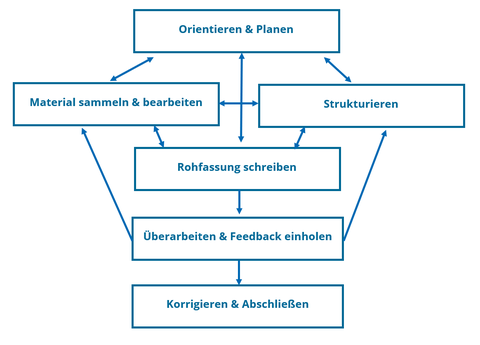Feb 03, 2023
Steep thesis: Clear rules in the writing process exist only for the external form of the text
The other day, a classic guidebook on academic writing fell into my hands again: How to Write an Academic Thesis by Umberto Eco. - One of many introductions intended to give students guidance in writing their papers in college. In it, Eco writes that the external composition of a text is the only thing in the process of writing a scientific paper for which there are "reasonably precise rules" (p. 3 f.).
Do you agree with this, dear readers? I asked myself the same question, and at first I immediately nodded my head. I was thinking of formal requirements such as: font, font size, line spacing, margins, formatting and numbering of headings, number of outline levels or design of highlights. Lecturers or institutes often have precise guidelines for this and corresponding guidelines or templates for students. I also count spelling and punctuation among the formalities.
What is my assessment at second glance? I would like to take a closer look at the writing process and, on the one hand, search for further clear or more or less clear guidelines and, on the other hand, for leeway in writing processes. - Without claiming to be exhaustive.
Guidlines in writing processes
First, I come to the (reasonably) clear guidelines. Three kinds come to mind here:
Citation
Where in the text are source citations placed? How are they formatted there and in the bibliography? How are direct quotations used correctly? If the lecturer does not specify a citation style, the standard is uniformity. Then you will follow a citation style that is common in your discipline, such as Harvard, APA, or Chicago, and implement it throughout. So even with citation, there are clear rules with selection of a particular system; something that can be worked off in a pattern-like fashion. (See SLUB materials on what and how to cite).
Structuring the work
Rules for outlining a paper? The outline, the red thread, the structure of the work depends on the topic and the question and therefore always differs individually, doesn't it? No. Because there are universal structures or components in scientific texts: The rough structure in introduction, main part, conclusion will certainly come to your mind immediately or also a structure common for articles in the STEM field, which provides for a division into the sections Introduction, Methods, Results and Discussion (IMRaD). What is presented in the individual sections also follows a uniform pattern or standard, e.g., that the introduction introduces the topic, formulates the research question, points out its relevance and the research gap, etc. So: Here, too, there are clear guidelines in some cases. (For structuring scientific papers, see the module "Structure" in the SZD online info library).
Writing comprehensibly
What makes a text understandable and easy to read, i.e. what makes its content quickly comprehensible, is the subject of various style guides. Here are recurring recommendations that I see as general rules for an understandably written text. These include, for example, forming sections of meaning, reader-guiding elements, avoiding nested sentences, precise statements instead of imprecise formulations, using technical terms, avoiding a high density of foreign words, and avoiding unnecessary filler words. Here, too, you can follow clear guidelines. (See recommended guides under "Literature tips" at the end of this article).
Freedoms in Writing Processes
What is not regulated, however, is how you organize your writing processes and approach writing itself. That is, there are no patent remedies here à la: follow this and you will bring your work to a ready-to-submit end in the time available, or do that and you will be able to write productively. The organization of the writing process and the writing itself are a matter of practice and an individual matter; as you gain writing experience, you will acquire strategies and methods that work for you.
Writing didactic advice or guidebook literature can at best support you in this process, i.e., show you options and give you recommendations along the way. Among them are these:

The model "Writing Dragon" we use at the SZD
- Certain steps in the research and writing process have to be taken in any case, and models like the "Writing Dragon", which we like to use at SZD for illustration, suggest a certain division into sub-steps or even a sequence. For example, from a writing didactics perspective, it is recommended to first write a rough draft, i.e., to write down a first draft of a text quite quickly and still with gaps, and then to revise it further, taking enough time for the revision in several loops, each with a different focus.
- How the development and writing of a text is approached is customizable. This applies to questions such as: How do I arrive at a question statement for my paper? How do I research and manage my literature effectively? What form of time management is helpful for me? How do I lose writing inhibitions and get started writing? (For an overview of methods, see the SZD online info-library).
- More specifically related to the text to be written per se: When to start writing and which parts of the paper to write when also has to do with personal preferences. For example, why should I first develop an outline and tweak the structure when I am much more comfortable developing my thoughts "on paper" and working out the structure in the process? In our last newsletter issue, Sharon's steep thesis already dealt with different writing strategies (planning, writing on the fly, patchwork, multi-version writing), which more experienced writers can use flexibly, e.g. depending on the type of text, content or time available.
So, after my brief foray into the writing process, I would like to state that there are more precise rules than the formal design of the text. Especially with the first papers written in university - and in general with every new type of text that one is still untrained to write - it is important to get to know them.
Want to know what this means for your writing process or course now?
For Students
- Get your bearings by finding out: What are the guidelines, requirements or expectations on the part of the lecturers? Which professional conventions should and can you orientate yourself to? Are there any guidelines in which these are made explicit? If not, ask around to get a clear picture of the type of text to be written and the requirements. (The SZD checklist for consultation with teachers can be a good basis for this).
- Use the office hours of your lecturers or the SZD writing consultation for feedback and exchange, e.g. regarding the outline or the argumentation structure of your papers.
- Talk to the peer writing advisors at the SZD writing consultation about how you can approach the development and writing of your papers, what has worked well so far, and what you could try out.
For Teachers
- Ask yourselves the question: What are the clear guidelines? What is clearly regulated in the writing process and what is not clearly regulated and potentially leads to uncertainty, disorientation or writer's block?
- Communicate the requirements and your expectations explicitly and transparently: make clear specifications in guides whenever possible. Point out what is important in the paper you are writing.
- Talk to students about how they approach writing and how you approach developing your text or the writing itself, what strategies have worked for you, what motivates you and makes it fun, and how you deal with the various challenges of writing.
Sources
Eco, Umberto. 2020. Wie man eine wissenschaftliche Abschlussarbeit schreibt: Doktor-, Diplom- und Magisterarbeit in den Geistes- und Sozialwissenschaften. 14., unveränderte Auflage. Stuttgart: UTB GmbH. (Zugang zur digitalen Ressource über die SLUB.)
Literature Recommendations
Esselborn-Krumbiegel, Helga. 2021. Richtig wissenschaftlich schreiben: Wissenschaftssprache in Regeln und Übungen. 6., aktualisierte Auflage. Paderborn: Ferdinand Schöningh. (Zugang zur digitalen Ressource über die SLUB.)
Kühtz, Stefan. 2018. Wissenschaftlich formulieren: Tipps und Textbausteine für Studium und Schule. 5., aktualisierte und erweiterte Auflage. Paderborn: Ferdinand Schöningh. (Zugang zur digitalen Ressource über die SLUB.)
Take a Look
Online Info-Library of the Writing Center that answers many questions surrounding the writing process.
 © Crispin-I. Mokry
© Crispin-I. Mokry
Consultant for Writing Didactics
NameNina Melching-Strathe, M.A.
Writing Center Team Leader | Services for Teachers
Send encrypted email via the SecureMail portal (for TUD external users only).
Center for Continuing Education
Center for Continuing Education
Visiting address:
Fritz-Foerster-Bau, 5th floor, room 557 Mommsenstr. 6
01069 Dresden
This post appeared on the occasion of the Febuary 2023 Writing Center Newsletter. This and other newsletter issues are linked in the Writing Center Newsletter Archive.
 © TUD
© TUD
Writing Center of TUD
Send encrypted email via the SecureMail portal (for TUD external users only).
Visiting address:
Fritz-Foerster-Bau, room 571 Mommsenstr. 6
01069 Dresden
Postal address:
TUD Dresden University of Technology
Zentrum für Weiterbildung/Career Service
Schreibzentrum
01062 Dresden
The Writing Center of the TU Dresden (SZD) supports students and lecturers with offers for planning and writing various texts in studies such as vouchers, protocols, seminar papers and theses and for teaching academic writing in teaching and supervision. All information about offers and possibilities of support can be found in the areas for students and teachers.

